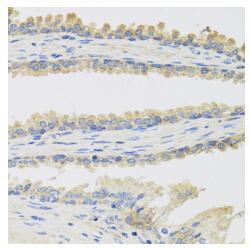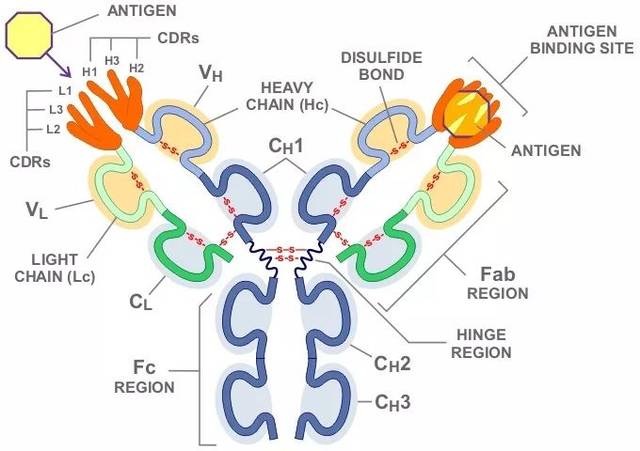Product Name :
INSL3 polyclonal antibody Background :
Insulin-like factor 3 (INSL3), also designated Leydig insulin-like peptide (Ley IL) and Relaxin-like factor (RLF), is a peptide hormone in the Relaxin family which is secreted from the testicular Leydig cells and ovarian theca interna cells. INSL3 is involved in gonadal and other physiological processes. Structurally similar to Relaxin and insulin, INSL3 differs from the two in that it signals through a G protein-coupled receptor, LGR8. INSL3/LGR8 signaling is involved in gubernaculum development and transabdominal testicular descent during development. Abnormal INSL3 production or action by the fetal testis causes cryptorchidism, a developmental defect of the urogenital tract in human males wherein the testis do not descend into the scrotum during embryonic development. Infertility and the development of germ-cell tumors are two potential risks for individuals with cryptorchidism. Product :
1mg/ml in PBS with 0.02% sodium azide, 50% glycerol, pH7.2 Storage&Stability :
Store at 4°C short term. Aliquot and store at -20°C long term. Avoid freeze-thaw cycles. Specificity :
INSL3 polyclonal antibody detects endogenous levels of INSL3 protein. Immunogen :
Recombinant fusion protein containing a sequence corresponding to amino acids 1-131 ofhuman INSL3 (NP_005534.2). Conjugate :
Unconjugated Modification :
Unmodified
INSL3 polyclonal antibody Background :
Insulin-like factor 3 (INSL3), also designated Leydig insulin-like peptide (Ley IL) and Relaxin-like factor (RLF), is a peptide hormone in the Relaxin family which is secreted from the testicular Leydig cells and ovarian theca interna cells. INSL3 is involved in gonadal and other physiological processes. Structurally similar to Relaxin and insulin, INSL3 differs from the two in that it signals through a G protein-coupled receptor, LGR8. INSL3/LGR8 signaling is involved in gubernaculum development and transabdominal testicular descent during development. Abnormal INSL3 production or action by the fetal testis causes cryptorchidism, a developmental defect of the urogenital tract in human males wherein the testis do not descend into the scrotum during embryonic development. Infertility and the development of germ-cell tumors are two potential risks for individuals with cryptorchidism. Product :
1mg/ml in PBS with 0.02% sodium azide, 50% glycerol, pH7.2 Storage&Stability :
Store at 4°C short term. Aliquot and store at -20°C long term. Avoid freeze-thaw cycles. Specificity :
INSL3 polyclonal antibody detects endogenous levels of INSL3 protein. Immunogen :
Recombinant fusion protein containing a sequence corresponding to amino acids 1-131 ofhuman INSL3 (NP_005534.2). Conjugate :
Unconjugated Modification :
Unmodified
-
 Immunohistochemistry analysis of paraffinembedded Human prostate using INSL3 pAb at dilution of 1:100 (40xlens).
Immunohistochemistry analysis of paraffinembedded Human prostate using INSL3 pAb at dilution of 1:100 (40xlens).
Bioworld Biotech only provide peptides for our antibodies and do not provide additional peptide customization services.
Price/Size :
USD 368/1mg/vial
Tips:
For phospho antibody, we provide phospho peptide(0.5mg) and non-phospho peptide(0.5mg).Describe :
Blocking peptides are peptides that bind specifically to the target antibody and block antibody binding. These peptide usually contains the epitope recognized by the antibody. Antibodies bound to the blocking peptide no longer bind to the epitope on the target protein. This mechanism is useful when non-specific binding is an issue, for example, in Western blotting (WB) and Immunohistochemistry (IHC). By comparing the staining from the blocked antibody versus the antibody alone, one can see which staining is specific; Specific binding will be absent from the western blot or IHC performed with the neutralized antibody.Formula:
Synthetic peptide was lyophilized with 100% acetonitrile and is supplied as a powder. Reconstitute with 0.1 ml DI water for a final concentration of 10 mg/ml.The purity is >90%,tested by HPLC and MS.
Storage:
The freeze-dried powder is more stable. For short time at 2-8°C. For long term storage store at -20°C.
Note :
This product is for research use only (RUO only). Not for use in diagnostic or therapeutic procedures.
 INSL3 polyclonal antibody
INSL3 polyclonal antibody  Datasheet
Datasheet COA
COA MSDS
MSDS SHIP
SHIP